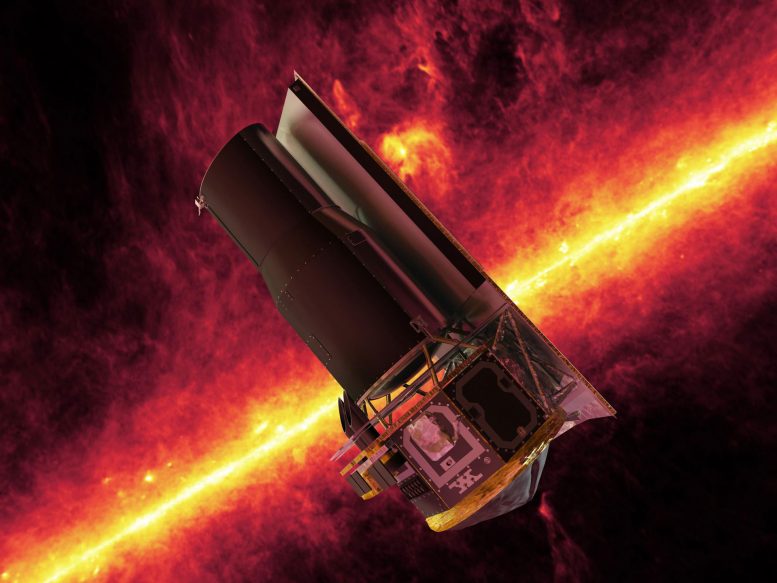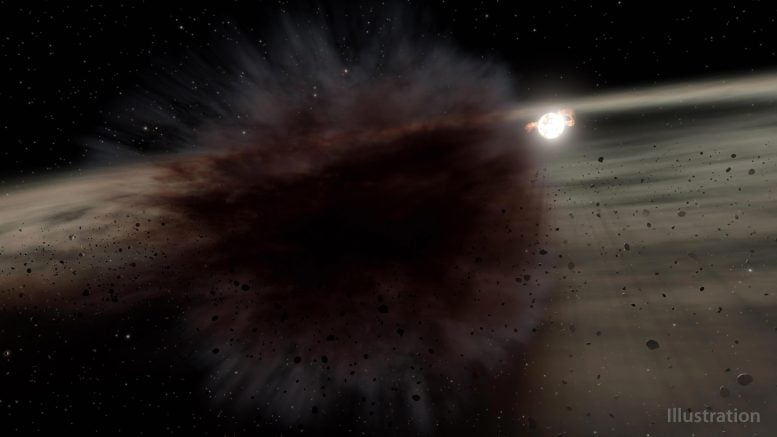Major smashups between rocky bodies shaped our solar system. Observations of a similar crash give clues about how frequent these events are around other stars.
Most of the rocky planets and satellites in our solar system, including Earth and the Moon, were formed or shaped by massive collisions early in the solar system’s history. By smashing together, rocky bodies can accumulate more material, increasing in size, or they can break apart into multiple smaller bodies.
Astronomers using
This illustration depicts the result of a collision between two large asteroid-sized bodies. NASA’s Spitzer saw a debris cloud block the star HD 166191, giving scientists details about the smashup that occurred. Credit: NASA/JPL-Caltech
“There is no substitute for being an eyewitness to an event,” said George Rieke, also at the University of Arizona and a coauthor of the new study. “All the cases reported previously from Spitzer have been unresolved, with only theoretical hypotheses about what the actual event and debris cloud might have looked like.”
Beginning in 2015, a team led by Su started making routine observations of a 10 million-year-old star called HD 166191. Around this early time in a star’s life, dust left over from its formation has clumped together to form rocky bodies called planetesimals – seeds of future planets. Once the gas that previously filled the space between those objects has dispersed, catastrophic collisions between them become common.
Anticipating they might see evidence of one of these collisions around HD 166191, the team used Spitzer to conduct more than 100 observations of the system between 2015 and 2019. While the planetesimals are too small and distant to resolve by telescope, their smashups produce large amounts of dust. Spitzer detected infrared light – or wavelengths slightly longer than what human eyes can see. Infrared is ideal for detecting dust, including the debris created by protoplanet collisions.

This image shows an artist’s impression of the Spitzer Space Telescope. The background shows an infrared image from Spitzer of the plane of the Milky Way galaxy. Credits: NASA/JPL
In mid-2018, the space telescope saw the HD 166191 system become significantly brighter, suggesting an increase in debris production. During that time, Spitzer also detected a debris cloud blocking the star. Combining Spitzer’s observation of the transit with observations by telescopes on the ground, the team could deduce the size and shape of the debris cloud.
Their work suggests the cloud was highly elongated, with a minimum estimated area three times that of the star. However, the amount of infrared brightening Spitzer saw suggests only a small portion of the cloud passed in front of the star and that the debris from this event covered an area hundreds of times larger than that of the star.
To produce a cloud that big, the objects in the main collision must have been the size of dwarf planets, like Vesta in our solar system – an object 330 miles (530 kilometers) wide located in the main asteroid belt between (function(d, s, id){
var js, fjs = d.getElementsByTagName(s)[0];
if (d.getElementById(id)) return;
js = d.createElement(s); js.id = id;
js.src = "https://connect.facebook.net/en_US/sdk.js#xfbml=1&version=v2.6";
fjs.parentNode.insertBefore(js, fjs);
}(document, 'script', 'facebook-jssdk'));
Read original article here
